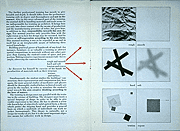Contributors
1934-1942
1934-1942
Walter Gropius
1883 - 1969 Walter
Gropius spent his first professional years in Peter Behrens studio.
It was here that he was first exposed to the beginnings of the modern
movement. In 1910 he left to form his own architectural firm. In
1918 he became the director of both the Grand Ducal School of Fine
Art and the Grand Ducal School of Arts and Crafts. He unified both
as the State Bauhaus in Weimar. When the school moved to Dessau,
he designed the entire Bauhaus building complex. This was an example
of Gropius' total work of art concept. Everything from the fittings
to the furniture and lightingand even the lettering came from the
Bauhaus workshops. In 1927 he participated in the Weissenhof exhibition
at Stuttgart with two building designs.
Walter
Gropius spent his first professional years in Peter Behrens studio.
It was here that he was first exposed to the beginnings of the modern
movement. In 1910 he left to form his own architectural firm. In
1918 he became the director of both the Grand Ducal School of Fine
Art and the Grand Ducal School of Arts and Crafts. He unified both
as the State Bauhaus in Weimar. When the school moved to Dessau,
he designed the entire Bauhaus building complex. This was an example
of Gropius' total work of art concept. Everything from the fittings
to the furniture and lightingand even the lettering came from the
Bauhaus workshops. In 1927 he participated in the Weissenhof exhibition
at Stuttgart with two building designs.
Gropius left the Bauhaus in 1928 to dedicate more time to his own practice. From 1934 - 1937 he worked in London with Max Fry and in 1937 emigrated to the United States. When he emigrated he was appointed professor of Architecture in the Graduate School of Design at Harvard. Marcel Breuer was appointed associate professor and together they established a private practice in 1938. After his partnership with Breuer dissolved, he created the Architects Collaborative. In addition to his private practice and responsibilities at Harvard, Gropius served from 1945-1949 as consultant architect for the Container Corporation of America. In 1955 he served as guest professor to the School of Design at Ulm. Gropius' long term influence on design did not end with his death in 1969. The legacy left by the school at the Bauhaus has spread and continues to prosper.